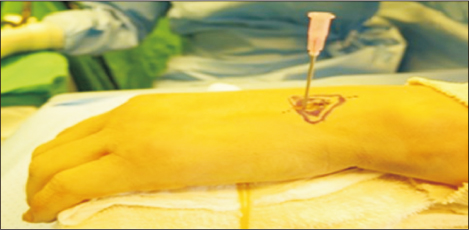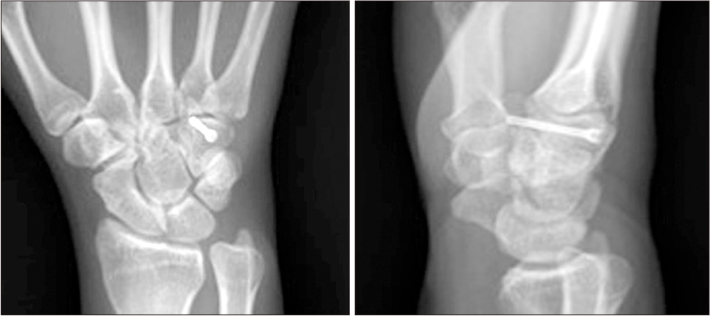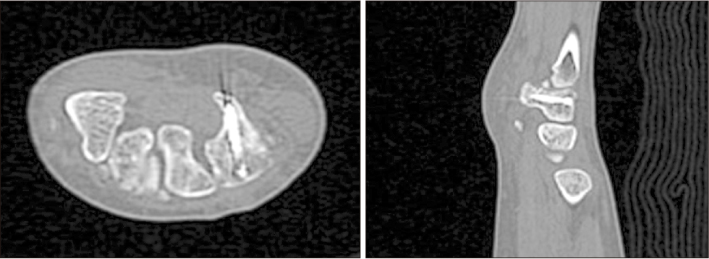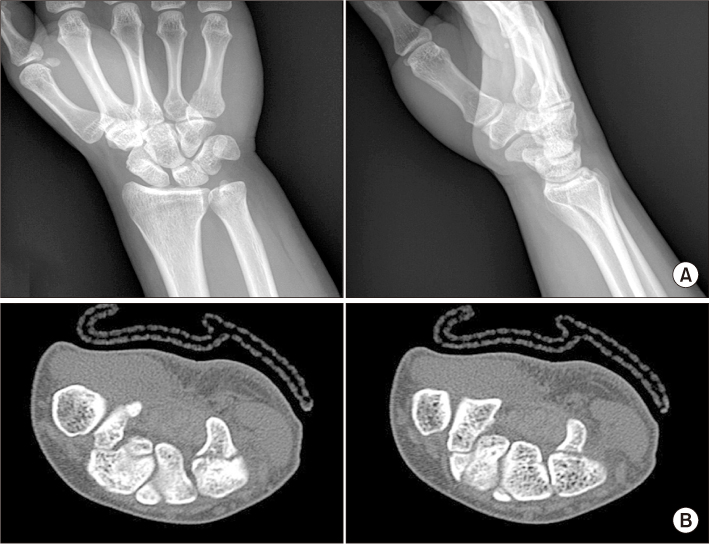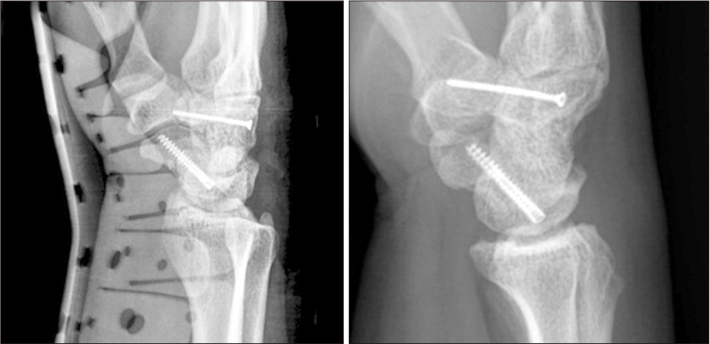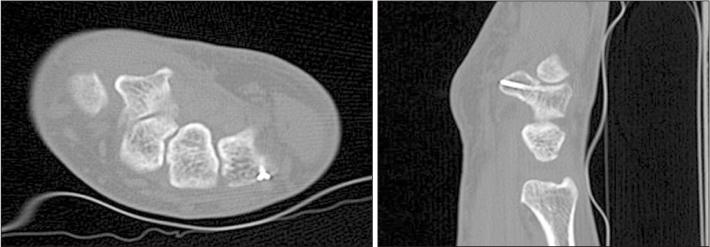Arch Hand Microsurg.
2017 Dec;22(4):273-279. 10.12790/ahm.2017.22.4.273.
Internal Fixation of Hamate Hook Fracture by Dorsal Percutaneous Headless Compression Screw and Cortical Screw: A Technical Note
- Affiliations
-
- 1Department of Orthopedic Surgery, Wonju Severance Christian Hospital, Yonsei University Wonju College of Medicine, Wonju, Korea. oir1128@daum.net
- KMID: 2406132
- DOI: http://doi.org/10.12790/ahm.2017.22.4.273
Abstract
- Hamate bone fracture is an uncommon injury, accounting for 2% of all carpal bone fractures. The common treatment of choice for hamate bone fractures is conservative treatment or excision of the hamate fracture fragment. We devised a new procedure that utilizes dorsal percutaneous compression screws for internal fixation. This technique was performed on two patients with left hamate hook base fractures. Tolerable active joint movement of the left wrist and fingers was permitted the first day post-surgery. Radiographs were taken after surgery, at 3 months, and at 6 months to determine the degree of union. No remarkable ligament injuries or nerve injuries were observed. This technique proved to be a relatively simple procedure when compared to the existing procedure while enabling early wrist movement. By preserving soft tissue, this procedure maintained blood supply decreasing risks of non-union. These advantages make this technique a recommendable new procedure for hamate hook fractures.
Figure
Reference
-
1. Milch H. Fracture of the hamate bone. J Bone Joint Surg. 1934; 16:459–462.2. Dobyns JH, Linscheid RL, Cooney WP 3rd. Fractures and dislocations on the wrist. In : Rockwood CA, Green DP, editors. Fractures in adults. 2nd ed. Philadelphia, PA: Lippincott Williams & Wilkins;1984. p. 411–451.3. Stark HH, Jobe FW, Boyes JH, Ashworth CR. Fracture of the hook of the hamate in athletes. J Bone Joint Surg Am. 1977; 59:575–582.
Article4. Whalen JL, Bishop AT, Linscheid RL. Nonoperative treatment of acute hamate hook fractures. J Hand Surg Am. 1992; 17:507–511.
Article5. Watson HK, Rogers WD. Nonunion of the hook of the hamate: an argument for bone grafting the nonunion. J Hand Surg Am. 1989; 14:486–490.
Article6. Demirkan F, Calandruccio JH, Diangelo D. Biomechanical evaluation of flexor tendon function after hamate hook excision. J Hand Surg Am. 2003; 28:138–143.
Article7. Foucher G, Schuind F, Merle M, Brunelli F. Fractures of the hook of the hamate. J Hand Surg Br. 1985; 10:205–210.
Article8. Marchessault J, Conti M, Baratz ME. Carpal fractures in athletes excluding the scaphoid. Hand Clin. 2009; 25:371–388.
Article9. Smith P 3rd, Wright TW, Wallace PF, Dell PC. Excision of the hook of the hamate: a retrospective survey and review of the literature. J Hand Surg Am. 1988; 13:612–615.
Article10. Bishop AT, Beckenbaugh RD. Fracture of the hamate hook. J Hand Surg Am. 1988; 13:135–139.
Article
- Full Text Links
- Actions
-
Cited
- CITED
-
- Close
- Share
- Similar articles
-
- A Comparative Study of Tensile Strength of Three Operative Fixation Techniques for Metacarpal Shaft Fractures in Adults: A Cadaver Study
- Headless Autocompression Screw Fixation of Scaphoid Fractures Using Open Dorsal Approach
- Minimal Invasive Fixation Methods for the Metacarpal Fracture
- Percutaneous Screw Fixation in a Displaced Pubic Fracture: Technical Note
- Treatment of Anterior Glenoid Rim Fracture with Comminuted Fragment Using Arthroscopic Reduction and AO Headless Compression Screw Fixation: A Case Report


